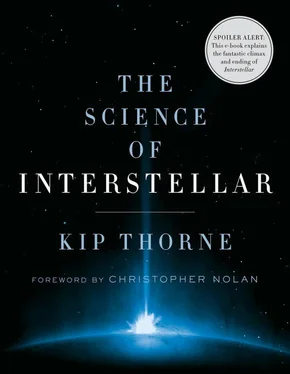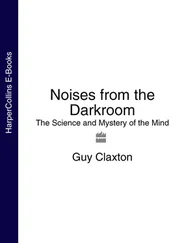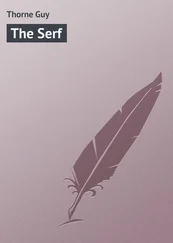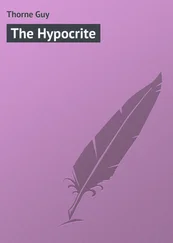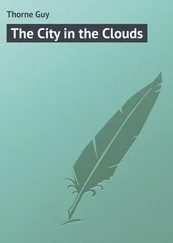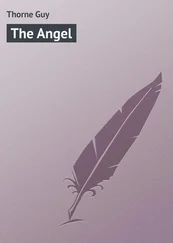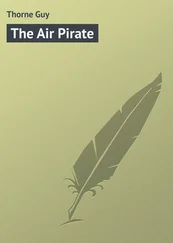
I doubt the laws of physics permit traversable wormholes, but this may be pure prejudice. I could be wrong. If they can exist, I doubt very much that they can form naturally in the astrophysical universe. My only real hope for forming them is artificially, in the hands of an ultra-advanced civilization. But we are extremely ignorant of how such a civilization could do it. And it appears more than daunting, at least from inside our brane (our universe), even for the most advanced of civilizations.
In Interstellar , however, the wormhole is thought to have been made, held open, and placed near Saturn by a civilization that lives in the bulk, a civilization whose beings have four space dimensions, like the bulk.
This is terra extremely incognita. Nevertheless, I discuss bulk beings in Chapter 22. In the meantime let’s talk about the wormhole in Interstellar .
15
Visualizing Interstellar ’s Wormhole

The wormhole in Interstellar is thought to have been constructed by an ultra-advanced civilization, most likely one that lives in the bulk. In this spirit, when laying foundations for visualizing Interstellar ’s wormhole, Oliver James [28] Recall that Oliver James, chief scientist at Double Negative, wrote the computer code that underlies Interstellar ’s visualizations of wormholes and black holes; see Chapters 1 and 8.
and I pretended we were ultra-advanced engineers. We assumed that wormholes are allowed by the laws of physics. We assumed the wormhole’s builders had all the exotic matter they needed to hold the wormhole open. We assumed the builders could warp space and time in whatever way we wished them to, inside and around the wormhole. These are pretty extreme assumptions, so I labeled this chapter  for speculation.
for speculation.
The Wormhole’s Gravity and Time Warping
Christopher Nolan wanted the wormhole to have a mild gravitational pull. Strong enough to hold the Endurance in orbit around itself, but weak enough that a modest rocket blast would slow the Endurance , letting it drop gently into the wormhole. This meant a gravitational pull much less than the Earth’s.
Einstein’s law of time warps tells us that the slowing of time inside the wormhole is proportional to the strength of the wormhole’s gravitational pull. With that pull weaker than the Earth’s pull, the slowing of time must be smaller than on Earth, which is only a part in a billion (that is, one second of slowing during a billion seconds of time, thirty years). Such slowing is so tiny that Oliver and I paid no attention to it at all when designing the wormhole.
“Handles” for Adjusting the Wormhole’s Shape
The ultimate decision about the wormhole’s shape was in the hands of Christopher Nolan (the director) and Paul Franklin (the visual-effects supervisor). My task was to give Oliver and his colleagues at Double Negative “handles” (or in technical language, “parameters”) that they could use to adjust the shape. They then simulated the wormhole’s appearance for various adjustments of the handles and showed the simulations to Chris and Paul, who chose the one that was most compelling.
I gave the wormhole’s shape three handles—three ways to adjust the shape (Figure 15.1).
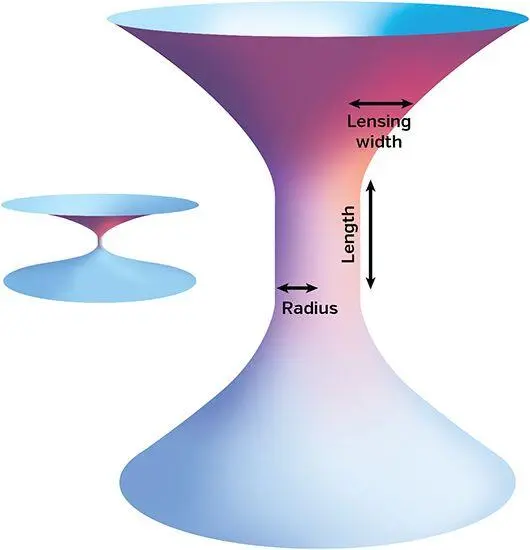
Fig. 15.1. A wormhole viewed from the bulk and my three handles for adjusting its shape. (The inset on the left is the same wormhole, viewed from farther away in the bulk so we see its outer parts.)
The first handle is the wormhole’s radius as measured by an ultra-advanced engineer looking in from the bulk (analog of Gargantua’s radius). If we multiply that radius by 2π = 6.28318…, we get the wormhole’s circumference as measured by Cooper when he pilots the Endurance around or through it. Chris chose the radius before I began to work. He wanted the wormhole’s gravitational lensing of stars to be barely visible from Earth with the best large-telescope technology then available to NASA. That fixed the radius at about a kilometer.
The second handle is the wormhole’s length , as measured equally well by Cooper or by an engineer in the bulk.
The third handle determines how strongly the wormhole lenses the light from objects behind it. The details of the lensing are fixed by the shape of space near the wormhole’s mouths. I chose that shape similar to the shape of space outside the horizon of a nonspinning black hole. My chosen shape has just one adjustable handle: the width of the region that produces strong lensing. I call this the lensing width [29] Most of the lensing occurs in the region where the wormhole’s shape in the bulk is strongly curved. This is the region where its outward slope is steeper than 45 degrees, so I define the lensing width to be the radial distance, in the bulk, from the wormhole throat to the location with 45-degree outward slope (Figure 15.1).
and depict it in Figure 15.1.
How the Handles Influence the Wormhole’s Appearance
Just as I had done for Gargantua (Chapter 8), I used Einstein’s relativistic laws to deduce equations for the paths of light rays around and through the wormhole, and I worked out a procedure for manipulating my equations to compute the wormhole’s gravitational lensing and thence what a camera sees when it orbits the wormhole or travels through it. After checking that my equations and procedure produced the kinds of images I expected, I sent them to Oliver and he wrote computer code capable of creating the quality IMAX images needed for the movie. Eugénie von Tunzelmann added background star fields and images of astronomical objects for the wormhole to lens, and then she, Oliver, and Paul began exploring the influence of my handles. Independently, I did my own explorations.
Eugénie kindly provided the pictures in Figures 15.2 and 15.4 for this book, in which we look at Saturn through the wormhole. (The resolutions of her pictures are far higher than my own crude computer code can produce.)
The Wormhole’s Length
We first explored the influence of the wormhole’s length, with modest lensing (small lensing width); see Figure 15.2.
When the wormhole is short (top picture), the camera sees one distorted image of Saturn through the wormhole, the primary image, filling the right half of the wormhole’s crystal-ball-like mouth. There is an extremely thin secondary, lenticular image on the left edge of the crystal ball. (The lenticular structure at the lower right is not Saturn; it is a distorted part of the external universe.)
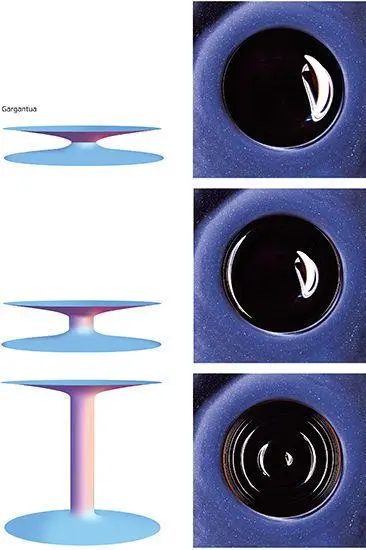
Fig. 15.2. Left : The wormhole, with small lensing width (just 5 percent of the wormhole’s radius), viewed from the bulk. Right : What the camera sees. Top to bottom : Increasing wormhole length: 0.01, 1, and 10 times the wormhole’s radius. [From simulations by Eugénie von Tunzelmann’s team using Oliver James’ code based on my equations.]
As the wormhole is lengthened (middle picture), the primary image shrinks and moves inward, the secondary image also moves inward, and a very thin lenticular tertiary image emerges from the right edge of the crystal ball.
Читать дальше
